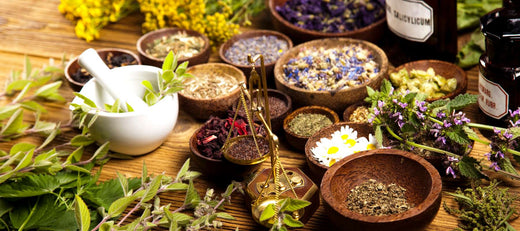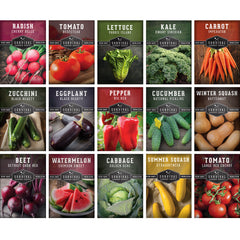Mint or genus Mentha is a member of the botanical family Lamiaceae, and there are close to 25 known species of this aromatic herb known worldwide. This perennial herb is a valuable and useful addition to any garden. Since there are so many varieties it might be hard to pick which ones to plant. Different varieties of mint offer an array of colors, aromas, and uses, so don’t be afraid to plant more than one type of mint.
Common Features of Mint
Despite there being so many varieties, most mints share a few characteristics in common.
- Similar appearance - ridged dark green leaves
- Fast growing and spreads easily through runners or stolons
- Hardy perennial
- Low maintenance
- Prefer part shade and moist soil
Uses for Mint
Mint is mostly known for its refreshing aroma and is most often used in cooking. It is also popular for making herbal tea to help soothe stomach and gastric ailments. Mint can also be used as a hair rinse, facial astringent, mouthwash, and breath freshener. It also works well as a natural insect repellent.
In addition, mint is a useful companion plant that will help attract helpful pollinators. Plant mint alongside brassicas like cabbage and kale, or carrots and tomatoes to help deter insect pests. Use mint as a mulch layer on the garden to help deter slugs and snails.
How to Grow Mint
Mint is easy to grow and highly adaptive to almost any soil. Mint seeds can be started indoors 8 to 10 weeks before your last frost. If you prefer to plant directly outside, wait until after the last frost and soil has warmed up in Spring. As a hardy perennial, mint can be planted in spring or early summer.
Mint seeds need light to germinate, so when sowing the seeds, do not cover them with additional soil, just press them lightly into the soil. They germinate best at soil temperatures between 60 and 70 Fahrenheit. Keep the soil moist, but not wet and you should see germination in 10 to 15 days under optimal conditions.
When transplanting mint seedlings, harden them off for a few days with progressive exposure to outdoor conditions. Because it can be invasive, it is recommended to plant mint in individual pots. Plant spacing should be about 18 to 25 inches. It grows best in partial shade with plenty of light. Perhaps best described as roots in the shade, and leaves in the sun. Keep plants well-watered to maintain consistently moist soil.
Cautions When Growing Mint
As wonderful as mint is, there are some challenges you may encounter when growing this herb.
Mint propagates through runners also known as stolons which are above-ground horizontal stems. These stolons can grow their own roots and establish new plants, so if you would like your mint to be confined to a specific area it is best to plant it in a container.
Since different species of mint have distinct aromas, if you would like to maintain those unique traits, you should keep different varieties separated from one another or they may cross-pollinate thus affecting the distinct aromas of the different varieties.
Mint can be grown indoors, however, you must take precautions to prevent the plant from becoming overcrowded in its container and be very careful not to overwater. When choosing a container, opt for one that is wider rather than deeper. This will keep the roots from encircling themselves and choking out the plant.
Types of Mint

Survival Garden Seeds currently offers 5 popular types of mint seeds for you to choose from.
- Spearmint (Mentha spicata) is one of the most popular mints due to its distinctive flavor and aroma. Also known as garden mint or common mint, spearmint is used as a flavoring in toothpaste as well as for multiple other culinary and medicinal uses. It can be identified by its bright green pointed leaves.
- Peppermint (Mentha x piperata) is a hybrid type of mint, a cross between spearmint and watermint. It is thought to have originated in the Mediterranean and North Africa. It shares many of the same uses as spearmint and can be identified by its distinctive purplish stems and pale violet flowers that bloom in mid to late summer.
- Lemon Mint (Monarda citriodora) is a member of the mint family native to North America. It is commonly known as lemon bee balm or lemon horsemint. It has a similar appearance to other mints but has a distinct lemony fragrance. This lemony flavor is often used to flavor teas, salads, and other dishes. Lemon mint also produces pale purple flowers that are attractive to butterflies and bees.
- Lemon Balm (Melissa officinalis) is another member of the Lamiaceae family with a lemony aroma. It has a long history of use in traditional medicine for its calming properties. Lemon balm has small white flowers and green serrated leaves.
- Catnip (Nepeta cataria) should not be confused with Cat Mint (Nepeta faassenii or Nepeta mussinii ). Catnip is a member of the Lamiaceae family known for containing the compound nepetalactone which can cause a state of excitement or euphoria in cats. Catnip is also used for medicinal purposes in humans. It has heart-shaped, toothed leaves and grows to about 3 feet tall. It produces spikes of pale purple or white flowers.
How to Harvest Mint

Harvesting mint is fairly straightforward. Harvesting in the morning is best because the essential oils in the plant are at their peak concentration. Simply pinch or snip the mint stems just above a pair of leaves with clean, sharp scissors or pruning shears. Be sure to leave some leaves on the stem for the plant to continue to grow. Regular harvesting and pruning will help keep good airflow within the plant so that it stays healthy. This will also prevent the plant from becoming “leggy” and woody.
How to Use and Store Mint
Fresh mint is a wonderful complement to meats and salads. Add some fresh spearmint to iced tea or lemonade. You can freeze mint leaves in ice cubes for future use or add them directly to beverages. Otherwise, you can dry mint for long-term storage and use in herbal tea.
Growing mint from seeds is an enjoyable and rewarding process that allows you to have an endless supply of this versatile herb. Whether you use it in cooking, making herbal tea, or simply enjoying the refreshing scent, your survival garden will benefit from the addition of mint plants.

























